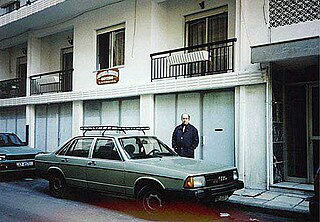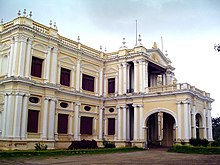The folklore of India encompasses the folklore of the nation of India and the Indian subcontinent. India is an ethnically and religiously diverse country. Given this diversity, it is difficult to generalize widely about the folklore of India as a unit.

Yakshagana is a traditional Indian theatre form, developed in Dakshina Kannada, Udupi, Uttara Kannada, Shimoga and western parts of Chikmagalur districts, in the state of Karnataka and in Kasaragod district in Kerala that combines dance, music, dialogue, costume, make-up, and stage techniques with a unique style and form. It is believed to have evolved from pre-classical music and theatre during the period of the Bhakti movement. It is sometimes simply called "Aata" or āṭa. This theatre style is mainly found in coastal regions of Karnataka in various forms. Towards the south from Dakshina kannada to Kasaragod of Tulu Nadu region, the form of Yakshagana is called as 'Thenku thittu' and towards north from Udupi up to Uttara Kannada it's called as'Badaga Thittu'. Both of these forms are equally played all over the region. Yakshagana is traditionally presented from dusk to dawn. Its stories are drawn from Ramayana, Mahabharata, Bhagavata and other epics from both Hindu and Jain and other ancient Indic traditions.

Folk art covers all forms of visual art made in the context of folk culture. Definitions vary, but generally the objects have practical utility of some kind, rather than being exclusively decorative. The makers of folk art are normally trained within a popular tradition, rather than in the fine art tradition of the culture. There is often overlap, or contested ground, with naive art, but in traditional societies where ethnographic art is still made, that term is normally used instead of "folk art".
Chamarajendra Academy of Visual Arts (CAVA) is a visual art school in Mysore, in the state of Karnataka in India. The academy is affiliated to the University of Mysore and offers courses in drawing, painting, sculpture, graphics, applied arts, photography and photo-journalism and art history. CAVA awards degrees in Bachelor of Fine Arts (BFA) and Master of Fine Arts (MFA).
The Center for Folklife & Cultural Heritage (CFCH) is one of three cultural centers within the Smithsonian Institution in the United States. Its motto is "culture of, by, and for the people", and it aims to encourage understanding and cultural sustainability through research, education, and community engagement. The CFCH contains (numerically) the largest collection in the Smithsonian, but is not fully open to the public. Its budget comes primarily from grants, trust monies, federal government appropriations, and gifts, with a small percentage coming from the main Smithsonian budget.

Karnataka has a variety of traditional arts, including folk dance and puppetry.

Channapatna toys are a particular form of wooden toys that are manufactured in the town of Channapatna in the Ramanagara district of Karnataka state, India. This traditional craft is protected as a geographical indication (GI) under the World Trade Organization, administered by the Government of Karnataka. As a result of the popularity of these toys, Channapatna is known as Gombegala Ooru (toy-town) of Karnataka. Traditionally, the work involved lacquering the wood of the Wrightia tinctoria tree, colloquially called Aale mara (ivory-wood).

The chande is a drum used in the traditional and classical music of South India and particularly in Yakshagana theatre art of Karnataka. It follows the Yakshagana Tala system. The rhythms are based on pre-classical music forms that Karnataka Sangeta and Hindustani Sangeetha are based on. There are different varieties of this instrument; two major varieties being the Badagu Thittu Chande and the Thenku Thittu Chande. The latter can also be spelled chenda and is used exclusively in the art forms of southern coastal Karnataka and Kerala. This article deals with Badagu Thittu Chande, used exclusively in Yakshagana of Karnataka. The chande used in Badagu Thittu is structurally and acoustically different from the chenda used in Kerala.
Old Belarusian History Museum is a museum in Minsk, Belarus.
Pravina Shukla, Ph.D. is Professor of Folklore at Indiana University Bloomington and serves as an adjunct faculty member in the Department of Anthropology, Department of American Studies, the Dhar India Studies Program, and the Center for Latin American and Caribbean Studies. She is also a consulting curator at the Mathers Museum of World Cultures.
Bharatiya Lok Kala Mandal is a cultural institution based in Udaipur in Rajasthan state in India engaged in studying folk art, culture, songs and festivals of Rajasthan, Gujarat and Madhya Pradesh and to popularise and propagate folk arts, folk dances and folk literature. It was founded by Padam Shri Late Devi Lal Samar in the year 1952. The institution has a museum that exhibits collection of folk articles from Rajasthan like rural-dresses, ornaments, puppets, masks, dolls, folk musical instruments, folk deities and paintings. There is puppet theater (Kathputli) too where puppet shows are held at regular intervals.

The Hadzilia Folklore and Ethnological Museum is a private museum in the northern Greek city of Serres, a collection built up over twenty years, which opened in June 1998. Housed on the ground floor of a building in Serres town centre, its purpose is to give the local people and visitors to the town an opportunity to learn something about folk culture.
P.R. Thippeswamy was an artist and folklorist of Karnataka. He was popularly known as PRT. He was instrumental in establishment of the "Folklore Museum" in Mysore in 1968. He was also the first curator of the museum. The folklore museum contains Representative collection of arts and crafts from all over Karnataka. P.R.Thippeswamy brought material from all over Karnataka to increase the collection. One of the displays in the museum is the "Ink" prepared locally by the great grandfather of the late P.R.Thippeswamy at Dodderi village of Chitradurga District 200 years ago.
Family folklore is the branch of folkloristics concerned with the study and use of folklore and traditional culture transmitted within an individual family group. This includes craft goods produced by family members or memorabilia that have been saved as reminders of family events. It includes family photos, photo albums, along with bundles of other pages held for posterity such as certificates, letters, journals, notes, and shopping lists. Family sayings and stories which recount true events are retold as a means of maintaining a common family identity. Family customs are performed, modified, sometimes forgotten, created or resurrected with great frequency. Each time the result is to define and solidify the perception of the family as unique.

Jaanapada Loka, is a folk museum that has an exclusive display of the village folk arts of Karnataka. It is under the aegis of the Karnataka Janapada Parishat. Loka Mahal, a wing in the museum has a display of 5,000 folk artifacts. It is situated in Ramanagara, Ramanagara district in the Indian state of Karnataka, on the Bangalore-Mysore highway, 53 kilometres (33 mi) to the south of Bangalore.

The Indian state, West Bengal has a rich cultural heritage. Due to the reign of many different rulers in the past, arts and crafts in West Bengal underwent many changes giving an artistic diversity today in the forms of traditional handicrafts, terracotta, painting and carving, dance, music except of natural beauty and glorious past the state has the strong hold of art and architecture which made the state so unique.

Srimanthi Bhai Memorial Government Museum Mangalore, Karnataka, Collection of archaeological and geological artefacts, a unit of Directorate of Archaeology & Museums Karnataka was founded in 4 May 1960 by Sri B.D Jatti, the chief minister of Karnataka Government. The museum is located in Mangalore, the coastal land of Karnataka.









